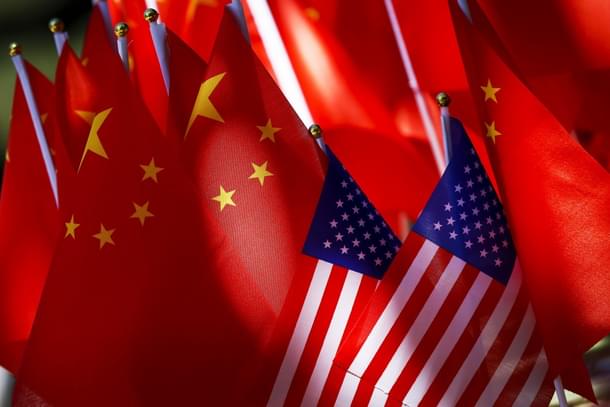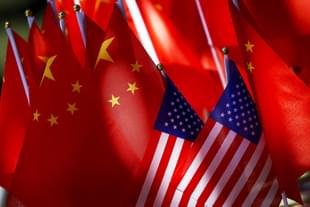World
It’s Not Just Import-Export: Four Major Reasons Why Xi And Trump Are Locked In A Battle Over Trade
Tushar Gupta
Oct 09, 2019, 01:42 PM | Updated 01:41 PM IST
Save & read from anywhere!
Bookmark stories for easy access on any device or the Swarajya app.


Later this week, delegations from the United States and China will resume their trade negotiations in an attempt to have a deal that satisfies both the parties.
In the event of a positive outcome, the Wall Street and companies with supply chains in China get a much-needed breather, and the deal will mark an end of the volatility and unpredictability that has governed trade relations between the two.
However, there is a possibility that the talks could go south due to the following reasons.
Firstly, the stock markets. Late last month, according to a report in Bloomberg, the White House was considering delisting Chinese companies from the US stock exchanges in order to limit the exposure to the Chinese market through government pension funds.
Led by the Alibaba Group with over $450 billion in market capitalisation, over 150 companies are listed in various US stock exchanges with a collective market capitalisation of over $1.2 trillion. Thus, the news of delisting had the markets tanking.
While one reason for this consideration was to limit the flow of American dollars into funding the communist regime in China, the main reason cited was the lack of financial information and disclosures by many public companies in the US.
However, the days of US dominance on world markets are over. Around the late 1990s, the US had over 8,000 companies listed on stock exchanges while China had less than 500. More than 20 years later, the number for China has increased 10-fold to more than 4,800 while the US has 4,400 listed companies.
Thus, love it or hate it, but the US or the average investing Joe cannot ignore China, even if President Donald Trump wants them to.
Two, there is a possible cold war brewing on the technology front. In the last few years, China has been encouraging domestic enterprises to invest in Western companies working on critical future technologies.
While Huawei is only a pawn in this larger game of trade chess, China has been heavily investing in areas like financial services, retail services, health and biotechnology. At its peak in 2016, the foreign investment stood at $37 billion.
This tech war took a new turn earlier this week as the US blocked eight artificial intelligence and tech companies and 20 other state-owned enterprises from buying goods made in the US.
Citing the reports of alleged human rights abuses against the Muslim minorities in Xinjiang region, the US has now made it mandatory for suppliers in the US to have special licence in case they intend to transact with these companies.
Interestingly, the news followed a report from the Financial Times stating that US officials were contemplating the idea of issuing credits to companies like Nokia and Ericsson to enable them to compete with Huawei, given how Huawei is now dominating the market for 5G equipment and is almost indispensable.
The fact that the White House is sceptical of Huawei is no surprise. The telecom equipment giant sells 28 per cent of the world’s telecom equipment, and in some countries, would be the only option to enable local 5G operations.
For the US, this tech war is not about companies or 5G, but about capacity building, given how the dominance of Chinese companies in areas of telecommunication, artificial intelligence, and other similar areas could pose a national security threat in the future. This is one warning India, with its huge market and population, must pay attention to.
Three, the tech war and pursuit of the capacity building also stems from the issue of theft of intellectual property (IP), an issue Trump has been vocal about lately.
While the US’ trade deficit with China stood at $420 billion, it’s the issue of IP theft that has cost the former heavily, a loss that cannot be accurately quantified.
According to a report published by The Commission on the Theft of American Intellectual Property, the annual cost to the US economy exceeds $225 billion in pirated and counterfeit goods and as high as $600 billion in other trade secrets. The same report expresses the inability to quantify the loss due to patent infringement. Additional $400 billion loss is attributed to economic espionage via hacking.
Four, the trade war is now venturing into the domestic affairs of China. Surprising observers across the globe by its sudden concern for Uighurs in China, the White House announced the introduction of visa restrictions connected to the mass detention and concentration camps in the Xinjiang region.
These diversionary tactics can be attributed to the failure of the US to get China to toe the line, as the Trump administration had hoped for.
Firstly, the import-export tariff-based structure has not been profitable to the US. In 2018, when the tariffs first came into play, Chinese exports to the US increased by $34 billion while US’ exports to China decreased by $10 billion. In 2019, US exports to China decreased by 24 per cent against 4 per cent decrease in Chinese exports to the US. The trade deficit, as in 2018, stands at $420 billion.
Two, while the impact of the tariffs is being borne by the average Joe, the Chinese have reduced tariffs for other trading partners for American goods impacted by tariffs in China. Thus, while an America family has to spend $620 more for the same goods, the Chinese have simply altered their choice of import nation.
Three, the Chinese government is reckless in its negotiations and conduct. While the backing of the state makes it easy for enterprises to survive the tariffs and White House shenanigans, the inability of most US companies to urgently move out their supply chains from China constrains the White House.
For China, a trade deal, or the lack of it, is not the end of the world, given they are now moving from an export-driven economy to one focused on domestic consumption.
Some numbers offer perspective here. In 2005, exports to the US made for 11 per cent of China’s GDP. By 2018, it was less than 4 per cent. In 2006, exports made up for 36 per cent of China’s economy, but by 2018, it was less than 18 per cent.
The trade war between Washington and Beijing is now about global supremacy. It stopped being merely about imports and exports long ago.
Tushar is a senior-sub-editor at Swarajya. He tweets at @Tushar15_




